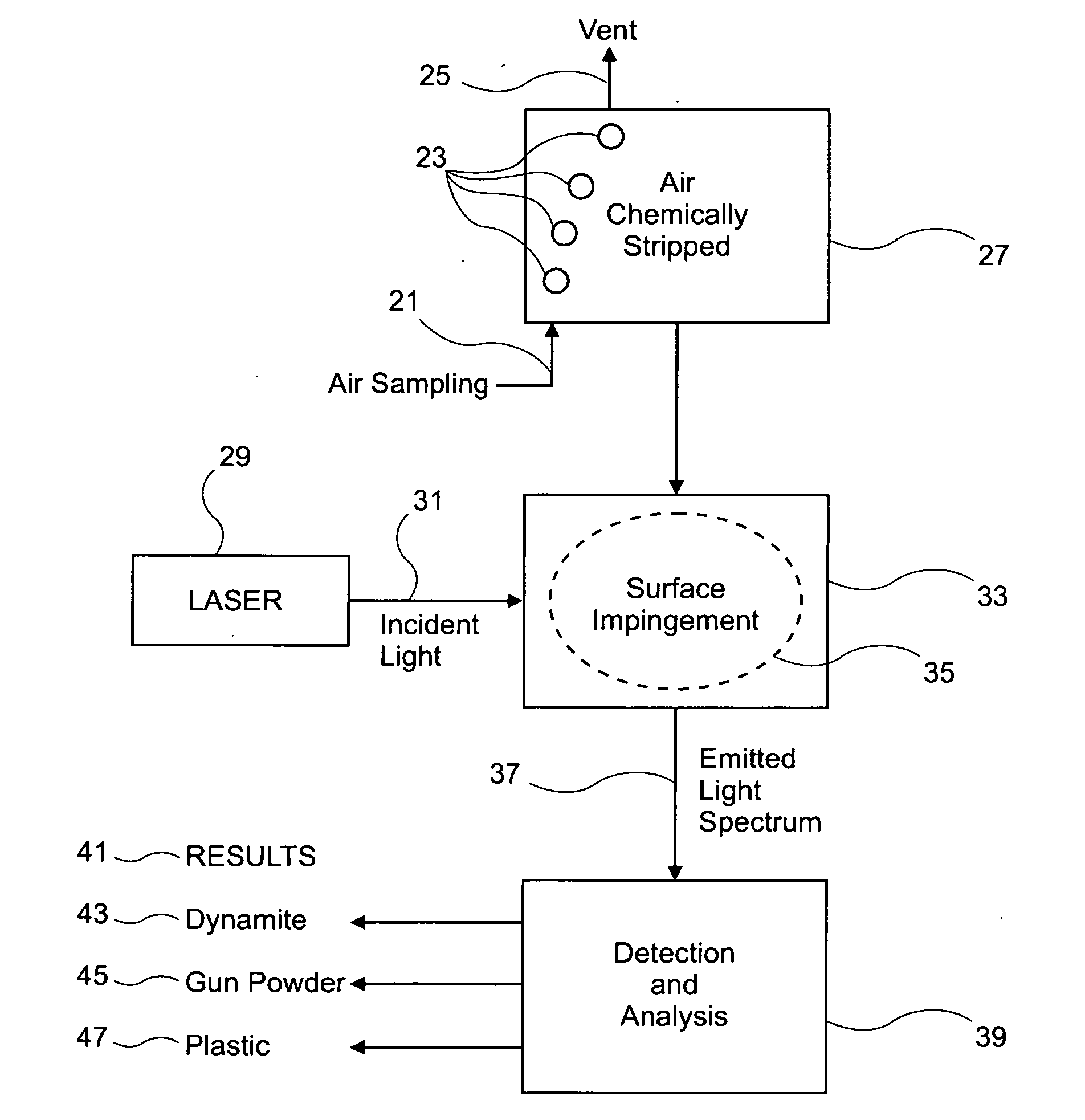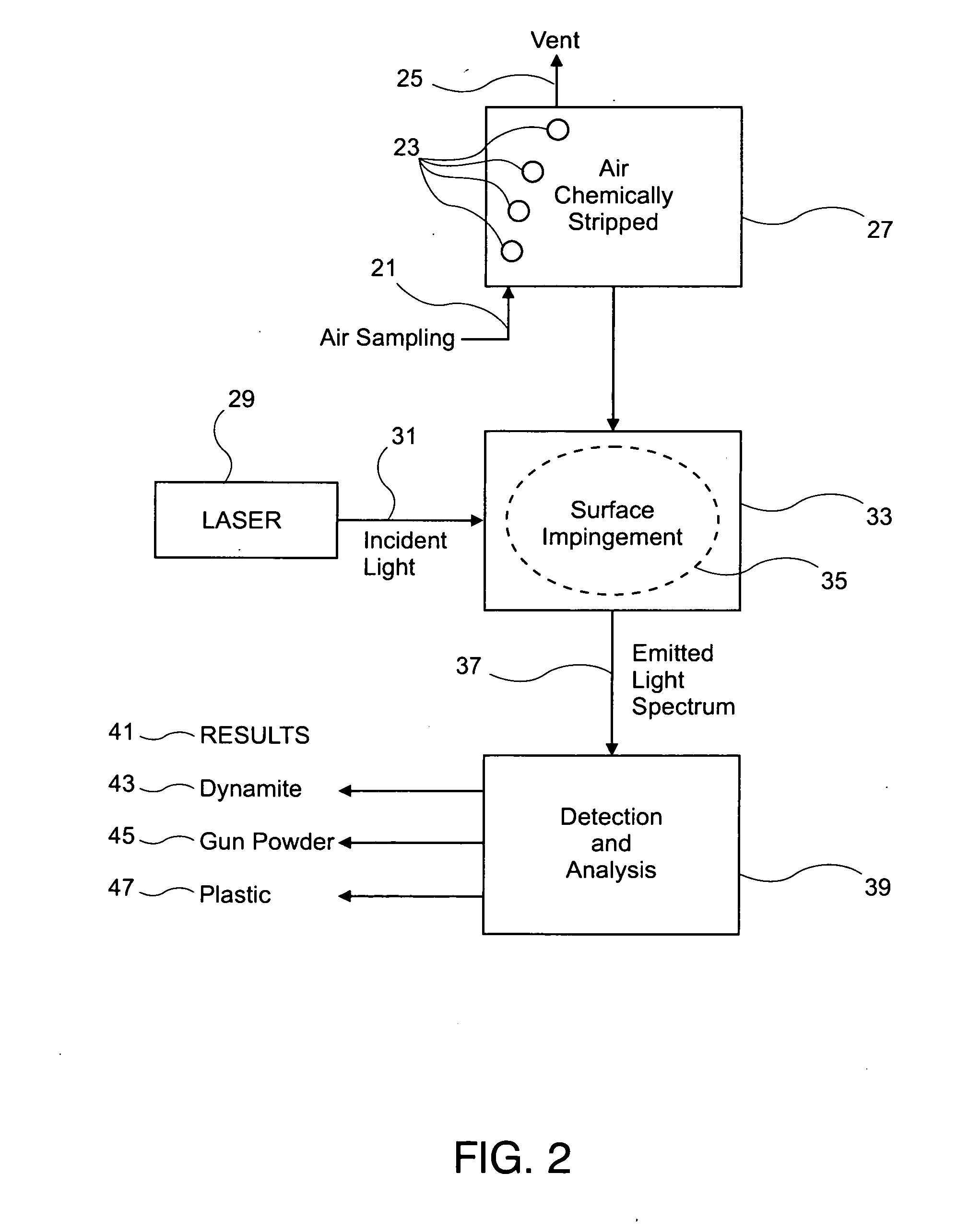Enhancing Raman spectrographic sensitivity by using solvent extraction of vapor or particulate trace materials, improved surface scatter from nano-structures on nano-particles, and volumetric integration of the Raman scatter from the nano-particles' surfaces
a raman spectrograph and solvent extraction technology, applied in the direction of material testing goods, instruments, analysis by subjecting materials to chemical reactions, etc., can solve the problems of delay in detection, too intrusive, and too expensive or difficult to provide in sufficient quantities. , to achieve the effect of cost-effective prophylaxis, identifying, treating and limiting any outbreak
- Summary
- Abstract
- Description
- Claims
- Application Information
AI Technical Summary
Benefits of technology
Problems solved by technology
Method used
Image
Examples
example 1
[0118]The present invention relates to a method to increase the Raman effect by multiple orders of magnitude by impingement and solvent-enhancement wherein the lower limit of detection is increased by providing 500 square meters of surface area for the impingement material made from porous silicon requiring a density approximating 5 molecules of trace material of interest for detection at one part per trillion (ppt) in air that is extracted by a solvent to determine the presence of the trace material of interest to a required density approximating 1 molecule of trace material of interest for detection at one ppt in the solvent to form a target. In this example the impingement material is made from porous silicon of nano-size structure of hollow or preferably tubular cross-section along its minor axis and said nano-size structures are arranged on a rigid substrate including silicon or flexible substrate such as polymeric films. A solvent is used to extract the trace materials residen...
example 2
[0119]The present invention relates to a method to increase the Raman effect by multiple orders of magnitude by solvent-enhancement and impingement wherein the impingement material is made from materials used in Affinity type High Performance Liquid Chromatograph (HPLC) that bind to proteins —NH2 and —COOH groups and the impingement material is made from pressure stable polymers, cross-linked agarose or polyacrylamide gels. In this example the solvent used to extract the trace materials resident on the impingement material is water and a computer analyzes and compares spectra to known spectra and communicates to physically separate instruments and computers. The sensor, utilizing one or dual wavelength near infrared laser light sources matched to at least one Charged Coupled Device (CCD) detector, senses spectra of Raman scattered light for sampled suspected of containing trace molecules of interest, and both is mounted remotely and communicates through Bluetooth software and equipm...
example 3
[0120]In this example the focusing wavelengths of light incident on the target sample are in the near infra-red region with one mono-chromatic laser light source at 785 nm and the other removed by one-half of the Raman spectrum band for the trace molecules of interest, or 200 to 150 nm shorter wavelength, so that the sensitivity to trace materials of interest is enhanced and florescence from the target is subtracted to improve the clarity of the Raman spectrum.
PUM
 Login to View More
Login to View More Abstract
Description
Claims
Application Information
 Login to View More
Login to View More - R&D
- Intellectual Property
- Life Sciences
- Materials
- Tech Scout
- Unparalleled Data Quality
- Higher Quality Content
- 60% Fewer Hallucinations
Browse by: Latest US Patents, China's latest patents, Technical Efficacy Thesaurus, Application Domain, Technology Topic, Popular Technical Reports.
© 2025 PatSnap. All rights reserved.Legal|Privacy policy|Modern Slavery Act Transparency Statement|Sitemap|About US| Contact US: help@patsnap.com



